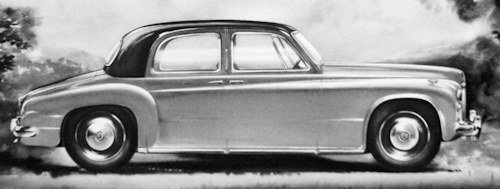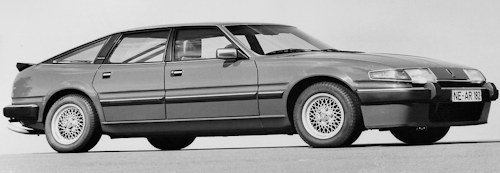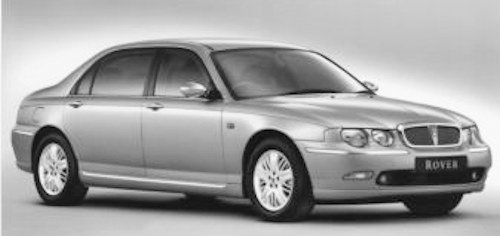Rover Company Limited History
Automotive manufacturer Longbridge; United Kingdom From 1896 to 2005.

Rover was a long established British car manufacturer based in England Great Britain that merged into Leyland Motors.
History
The first Rover was a 3-wheel tricycle manufactured by JK Starley & Sutton Co. in Coventry, UK in 1884. In 1888, a prototype of an electric vehicle was built, but never produced .Later In 1896, the company renamed to Rover Cycle Company. In 1904, the first car was produced, a two-seater called Rover Eight. On a trip from London to Constantinople, this car proved its reliability. In 1906, the company was renamed The Rover Company Limited.In the years to 1907 followed the 16/20 HP, the 10/12 HP and a 12 HP. A 20 HP won in 1907 the Tourist Trophy on the Isle of Man. In 1923 and the company was named Rover.
After 1918, the air-cooled 8-HP two-cylinder car, and within five years 17,000 were sold. 1925 came the Rover 14/45-HP. With a Rover Light-Six in 1930 a famous race against the Train Bleu, a famous express train on the route St. Raphael - Calais, and won with 20 minutes of advantage. Until 1936, several four- and six-cylinder models.
After the Second World War, the company in 1947 began production of the Land Rover, a versatile off-road vehicle with all-wheel drive, which was originally intended for agriculture; In order to save steel, the structure consisted of aluminium sheet, which was riveted to a tubular steel skeleton. Within a short time, this Land Rover became a bestseller.

1940s
Already in the late 1940s, the company began to experiment with gas turbines as a drive and developed prototypes, in 1950 the JET-1 was introduced. In the years 1953 to 1961 further prototypes were developed with gas turbines. In 1963, a 150 hp gas turbine was installed in a BRM racing car and started at the 24 Hours of Le Mans with an average speed of 173 km / h.

1949 appeared the new Rover 60 with four-cylinder engine and the Rover 75 with six cylinders. From 1958, the P5 was built, a coupe and a sedan with three-litre six-cylinder engine and from 1967 with V-8 engine and 3.5 litre displacement (P5B). These vehicles were able to establish themselves well in the upper segment market ad well as the later Range Rover.
1960s
In 1965 Rover merged with Alvis Limited and in 1967 the merger with Leyland Motor Corporation took place. Rover became part of the Leyland Motor Company, which became the British Leyland Motor Corporation, British Leyland, with the British Motor Corporation (BMC). From 1972, the company was Rover-British Leyland UK Limited.
Rover was just one more brand among many in a huge conglomeration of different companies like Austin, Jaguar, Morris, MG, Triumph, Wolseley, Leyland Motors (Commercial Vehicles) and others. This was the time of Rover as an independent company came to an end, from which also began the decline of the British auto industry.
1970s
By the mid-1970s Rover presented Rover SD1 an excellent car, but could never drop its bad reputation due to manufacturing and quality defects. In the same year British Leyland was insolvent and was then nationalized. The Land Rover or Range Rover off-road vehicles alone continued to have a large following.

1980s
In the early 1980s, a cooperation with Honda came about, under which a number of vehicles were developed together. Honda also acquired a 20 percent minority stake in Rover. The company changed its name to the Austin Rover Group in 1982.
After Jaguar was spun off in 1984, this used from 1988 again the name Rover Group. At this time, also based on Honda models Rover 400 (Honda Civic) and 600 (Honda Accord) and the Rover 200, the long-established first completely new model. The top model 800, which was released in autumn 1986, Also still on offer as was the original Mini.
1990s
In 1994, Austin Rover was taken over by the BMW Group. After a restructuring the models 75, 25 (based on the 200) and the 45 (still based on Honda 400). In addition, the mid-engine roadster MG F presented in autumn 1995 was also produced. Because of the already known at the launch of the Rover 75 problems between BMW and Rover and the resulting uncertainty about Rover’s future, as they could not achieve the targeted sales. The acquisition by BMW also ended the long-term development cooperation with Honda, which also had high hopes for the acquisition of the Rover Group.

2000s
In 2000, Rover was spun off the BMW Group again. The SUV brand Land Rover came to the Ford Group, the almost finished developed new Mini remained at BMW. Mini now could be established as a separate brand as BMW owned the brand.
Owner of the remaining Rover Group became the Phoenix Venture Group, consisting of four businessmen from Birmingham, which Rover took over from BMW for lack of further interest for the symbolic sum of 10 pounds. BMW granted the new management a long-term interest-free loan of £ 500m. However, MG Rover had to buy in return the BMW Group Powertrain engine division. In the hope of being able to arouse greater interest in the automotive market with the "sporting" brand MG, as the company MG Rover Group. Particularly sporty models were subsequently given the traditional name MG, as the MG ZT 260 based on the Rover 75 with a Ford-bought 4.6-liter V8 engine with 191 kW (260 hp). A supercar named MG SV-R, based on the Vale Mangusta, with only 50 made.
In 2004, Rover, with 6,000 employees, produced 100,000 cars at Longbridge. That was less than half of the capacity needed to reach the profit zone. In the same year were negotiated a joint venture with the Chinese Shanghai Automotive Industry Corporation (SAIC). SAIC wanted to invest in a joint venture with Rover 1.5 billion euros, including the development of new vehicle models. With the approval of the Chinese government, the contract was expected to be signed in 2005. Ultimately, however, the negotiations failed due to the unsecured liquidity of MG Rover, although the British government promised a subsidy of 100 million pounds. The MG Rover Group then became the last remaining British-owned mass-produced vehicle to declare bankruptcy on April 7, 2005. Phoenix Venture Holdings (PVH), the owner of the British car maker, offered a total of € 71 million in cash, shares and property (for example, the castle, estimated at € 12 million) Studley in Warwickshire / Central England) to help rescue the company.
The Racing Division of MG Rover, MG Sport and Racing Limited (MGSR), was to be sold separately as an independent company within the MG Rover Group. The racing project in the DTM and the construction of the sports car MG SVR were to be continued by the 48 employees of the MGSR. SAIC did not rule out new talks despite the cancellation, but it should wait to see what would be left on the balance sheet as Rover's assets after the bankruptcy process has been completed.
In July 2005, the assets of MG Rover and one of its subsidiaries, the engine manufacturer Powertrain Ltd., were acquired by the Chinese group Nanjing Automobile Corporation for more than £ 50 million. In March 2006, Nanjing announced that from the beginning of 2007 models of MG Rover in the UK and Spain should be sold. This was due to Rover's strong sales last in these markets. Initially, a revised MG TF and the MG 7, a completely revised version of the MG ZT, were to be offered. End of 2007 should follow the MG 5 as the successor to the Rover 45.
In September 2006, BMW sold the naming rights to Rover surprisingly to the Ford Group, although it was expected. The Rover brand licenses went to the Shanghai Automotive Industrial Corporation (SAIC) for more than 16 million euros, as SAIC had already secured the design rights to the Rover models 25 and 75. The Ford group had already acquired the Land Rover brand in 2000 and secured the right of first refusal for Rover.
In March 2008, Tata Motors acquired from Ford with the purchase of Jaguar and Land Rover, in addition to the trademark rights to the Daimler Motor Company and the Lanchester Motor Company, the trademark rights to the Rover brand.
Description
Technical
-
Rover models timeline
1904-1940
Type
Construction period
Cylinder / valve control
capacity
power
Rover 6
1906-1912
1 / sv
780-812 cm³
6 bhp (4 kW)
Rover 6/21
1923
6 / sv
3446 cc
Rover 8
1904-1912, 1919-1924
1-2 / sv
998-1327 cc
8-13 bhp (6-9.5 kW)
Rover 9/20
1924-1927
4 / ohv
1074 cc
20 bhp (15 kW)
Rover 10
1934-1940
4 / ohv
1389 cc
44 bhp (32 kW)
Rover 10-12
1906-1907
4 / sv
1767 cc
Rover 10/25
1928-1933
4 / ohv
1185 cc
25-27 bhp (18-20 kW)
Rover 12th
1909-1915, 1934-1940
2-4 / ohv
1496-2297 cm³
12-48 bhp (9-35 kW)
Rover 12/14
1912-1925
4 / sv
2297 cc
28 bhp (21 kW)
Rover 14th
1933-1940
6 / ohv
1577-1901 cm³
54 bhp (40 kW)
Rover 14/45
1924-1928
4 / ohc
2132 cc
45 bhp (33 kW)
Rover 15
1909-1911
4 / sv
2488 cc
Rover 16
1927-1932, 1937-1940
6 / ohv
2023-2147 cm³
Rover 16-20
1906-1907
4 / sv
3119 cm³
Rover 16/50
1926-1929
4 / ohc
2413 cc
50 bhp (37 kW)
Rover 18
1912-1913
4 / sv
3307 cc
35 bhp (25.7 kW)
Rover 20
1908-1910, 1931, 1939-1940
4-6 / sv + ohv
2512-3251 cm³
Rover Knight
1911-1912
1 / slide
1389 cc
9 bhp (6.6 kW)
Rover Meteor 16
1933
6 / ohv
2022 cm³
45 bhp (33 kW)
Rover Meteor 20
1931-1933
6 / ohv
2565 cc
60 bhp (44 kW)
Rover Pilot 12
1932
6 / ohv
1410 cm³
30 bhp (22 kW)
Rover Pilot 14
1932
6 / ohv
1577 cc
35 bhp (26 kW)
Rover Speed 14
1934-1935
6 / ohv
1577 cc
54 bhp (40 kW)
Rover Speed 16
1934-1935
4 / ohv
2023 cm³
Rover Speed 20
1934-1935, 1937-1940
6 / ohv
2512-2565 cm³
72 bhp (53 kW)
Rover Speed Pilot
1933
6 / ohv
1577 cc
44 bhp (32 kW)
1945-2005
Type
Construction period
Cylinder / valve control
capacity
power
Rover 10
1945-1948
4 / ohv
1389 cc
44 bhp (32 kW)
Rover 12th
1945-1948
4 / ohv
1496 cc
48 bhp (35 kW)
Rover 14th
1945-1948
6 / ohv
1901 cm³
54 bhp (40 kW)
Rover 16
1945-1948
6 / ohv
2147 cc
Rover 25th
1999-2005
4 / ohc
1400-2000 cc
84-145 bhp (62-107 kW)
Rover 45
1999-2005
4-6 / ohc
1400-2000 cc
103-150 bhp (76-110 kW)
Rover 75
1998-2005
4-8 / ohc
1800-4600 cc
120-260 bhp (88-191 kW)
Rover 100 series
1990-1998
4 / ohc
1100-1500 cc
60-103 bhp (44-76 kW)
Rover 200 Series
1984-1999
4 / ohc
1100-2000 cc
60-200 bhp (44-147 kW)
Rover 400 series
1990-1999
4 / ohc
1400-2000 cc
103-136 bhp (76-100 kW)
Rover 600 series
1993-1999
4 / ohc
1800-2300 cc
105-200 bhp (85-147 kW)
Rover 800 Series
1986-1999
4-6 / ohc
2000-2700 cc
120-200 bhp (88-147 kW)
Rover-Alvis P6-BS
1967
8 / ohv
3528 cm³
150 bhp (110 kW)
City Rover
2003-2005
4 / ohc
1400 cc
84 bhp (62 kW)
Rover gas turbine vehicles
1947-1965
gas turbine
100-230 bhp (74-169 kW)
Rover Metro
1980-1994
4-6 / ohc
998-2991 cm³
Rover MI
1947
4 / oise
699 cc
28 bhp (20.6 kW)
Rover P3
1948-1949
4-6 / oise
1595-2103 cm³
51-72 bhp (37.5-53 kW)
Rover P4
1949-1964
4-6 / oise + ohv
1997-2639 cm³
60-123 bhp (44-90.5 kW)
Rover P5
1958-1973
6-8 / oise + ohv
2995-3528 cm³
128-145 bhp (94-105 kW)
Rover P6
1963-1977
4-8 / ohc + ohv
1978-3528 cm³
120-145 bhp (88-105 kW)
Rover SD1
1976-1986
4-8 / OHC / OHV & ohv
2000,2300,2600 & 3528 cc
Rover Streetwise
2003-2005
4 / ohc
1400-2000 cc
84-145 bhp (62-105 kW)

